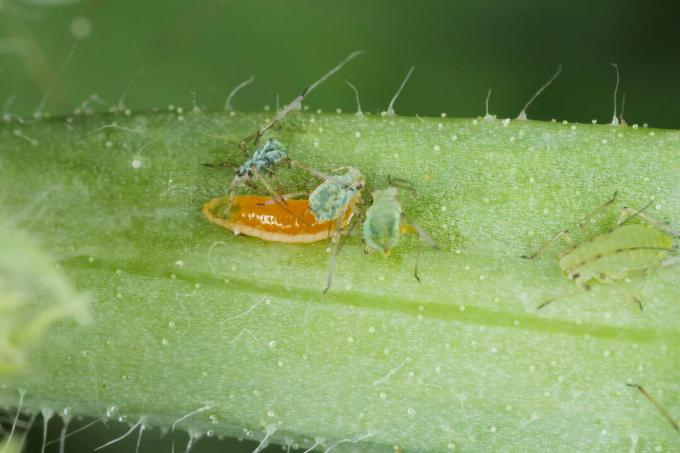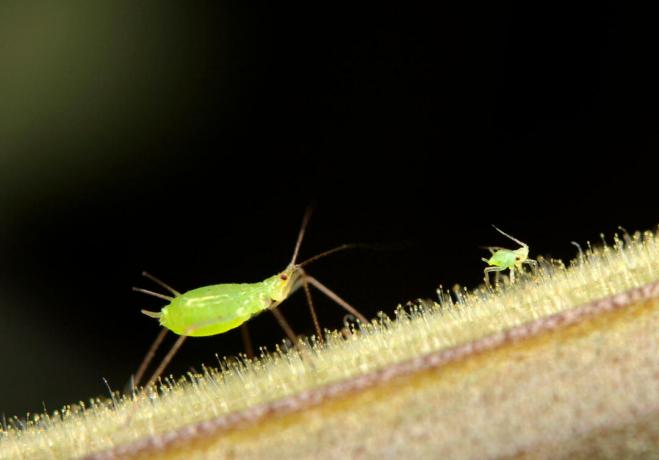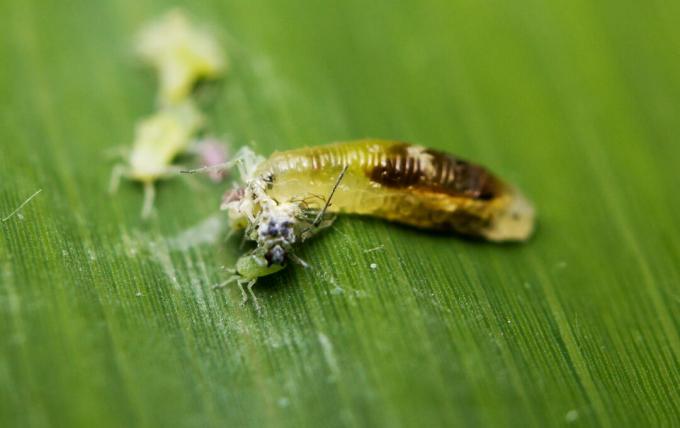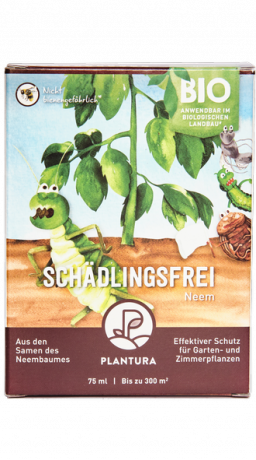Gall midges can be really beneficial in the garden, for example when fighting aphids. More information on the gall midge can be found here.

When we hear the name "gall midges", we don't immediately think of a beneficial insect that can be used in the garden. Most of us will surely see misshapen and colorful galls on our ornamental plants, which can be caused by various gall midges. But we will show you below that this insect can also have useful properties.
contents
- Gall midge: profile and properties
- Buying gall midges: you need to pay attention to this
-
Use gall midges against aphids in the garden
- Application of gall midges against aphids
- The right time to use gall midges against aphids
The family of gall midges (Cecidomyidae) is divided into six different subfamilies, there are a total of around 6000 different species - these include not only the gall midges in the narrower sense, but also wood gnats. In this article, however, we deal with the gall midge larvae, which prey on the
aphids feed and are therefore optimal beneficials for us gardeners.Gall midge: profile and properties
The predatory larvae of the gall midge (Aphidoles aphidimyza) feed on various aphids that cavort on our plants in the garden. This gall midge also originally comes from Central Europe, which is why it is even possible for this beneficial insect to migrate into your glass house by itself. The larvae of gall midges are orange in color and range in size from 0.5 to 4.0 millimeters. After the larvae have hatched from their eggs, they start looking for aphids. Once they find one, they pierce it and inject a poison, paralyzing the aphid. The gall midge larvae then suck out the paralyzed aphid until only the body shell is left. A gall midge larva can suck out and kill a total of 50 to 100 aphids.

After several larval stages, the gall midge larvae drop to the ground and pupate. The adult gall midges, which are brown in color and about two millimeters in size, then hatch from these pupae. The curved feelers of the adult gall midges are particularly striking, which has also earned the males the nickname "ram's head". At a temperature of 25 °C, adult gall midges live for about one to two weeks, during which time a female can lay up to 200 eggs. She then lays her eggs in the midst of aphid colonies, which the nocturnal gall midges track down by the attracting scent of honeydew. And so the process starts all over again. The entire development from egg to adult insect takes about two to three weeks.
Buying gall midges: you need to pay attention to this
Gall midges are generally used in greenhouses, polytunnels and indoors to control aphids. In conservatories or in small conservatories that are less than ten square meters in area, you should not put gall midges because the necessary humidity is not reached there and the gall midges do not develop optimally there be able. When you buy gall midges, you always get a carrier material such as soil, sand or vermiculite, in which the gall midge pupae are then located. The adult animals hatch from these pupae and lay their eggs between the aphid colonies. You can use gall midges from March to September, but it is not possible to use them in the winter months gall midges go into hibernation when the length of daylight falls below 16 hours and the temperature falls below 10 °C sinks. The gall midge larvae then pupate in the soil and do not hatch again until the following spring.

Use gall midges against aphids in the garden
When using purchased beneficial insects, you should pay attention to a few things so that you can count on successful control. As soon as you receive the gall midges for aphid control, you should apply them immediately. If this is not possible, the beneficial insects are stored in a cool place at 10 to 15 °C.
Application of gall midges against aphids
To use, simply scatter the material with the gall midge pupae in it or make small piles that you distribute throughout the garden or around the infested plants. Make sure that the soil on which you spread the gall midges is damp but not wet. You can also place the opened container with the gall midge pupae in a shady spot on your greenhouse floor. Make sure, however, that the containers are protected against dripping water.

There is also the possibility of "open breeding", which often achieves better results than just bringing out the pupal stages. In open breeding, potted crops are grown on which crop aphids live, such as the large crop aphid (Macrosiphum avenae). The gall midges are raised on these grain plants, and the whole pots are placed in the greenhouses. There is no need to worry about grain aphids, as they infest vegetable or ornamental plants. All the developmental stages of the gall midge are found on these plants, so control can begin immediately and be continuous.
The right time to use gall midges against aphids
You can use gall midges from March to September, but the temperature should be above 16 °C and the relative humidity should be at least 60% for successful control is. For an area of one square meter you need about one to three gall midges to fight aphids. If the use of gall midges is successful, after two to three weeks you should be able to see the orange-colored larvae surrounding the aphid herd.

tip: Gall midges fight all aphid species that can be found in domestic greenhouses. However, the use of the green cucumber aphid (Aphis gossypii), the green peach aphid (Myzus persicae) and the green-striped potato aphid (Macrosiphum euphorbiae).
Important tips for the application of gall midges:
- Use as bedding or from open breeding
- Can be used from March to September
- Only suitable for protected cultivation (glass house, foil tunnel, indoor areas).
- 1 to 3 gall midge larvae for 1 m² area
- A gall midge larva can kill up to 100 aphids
If you cannot control the aphid infestation in the garden with gall midges alone, there is another natural way to fight the pests: with our Plantura Organic Pest Free Neem made from 100% plant-based ingredients, aphids and the like will soon no longer be an issue.

Plantura Organic Pest Free Neem
Highly effective & natural spray
against aphids, potato beetles & Co,
from the seeds of the neem tree
You can find more here Tips and tricks in the fight against aphids. You can also use other beneficial insects such as lacewings and lacewing larvae use against aphids.
...and receive concentrated plant knowledge and inspiration directly in your e-mail inbox every Sunday!
